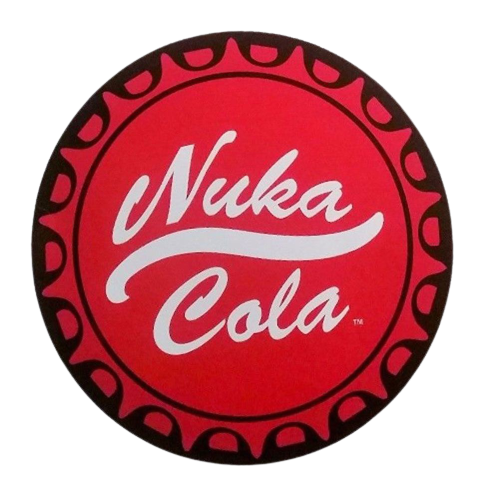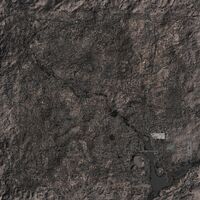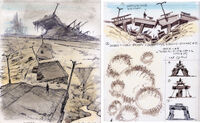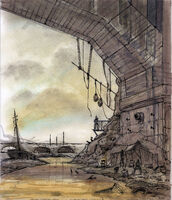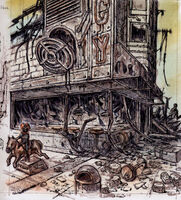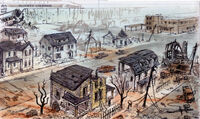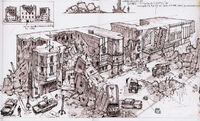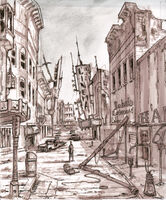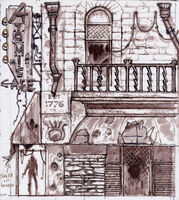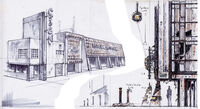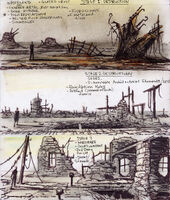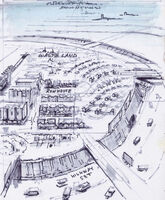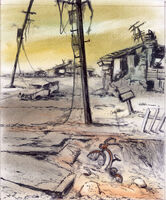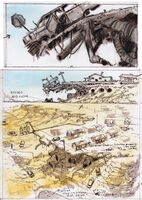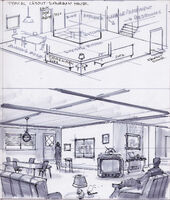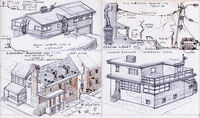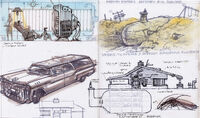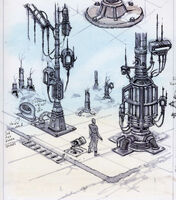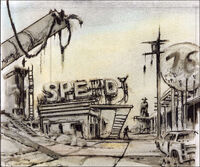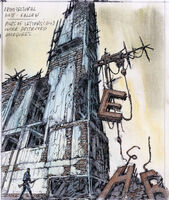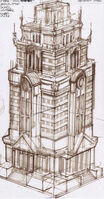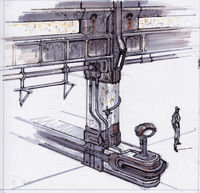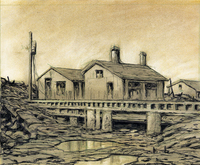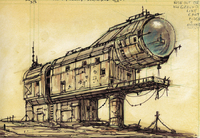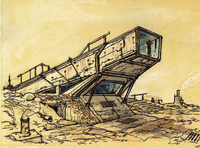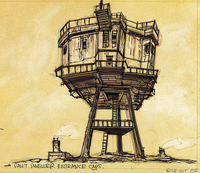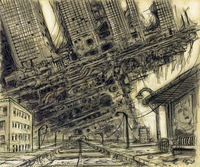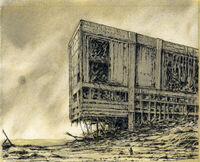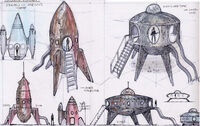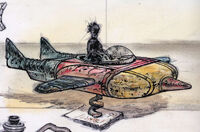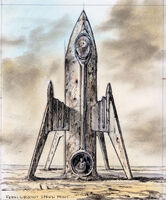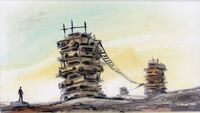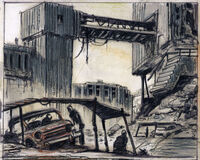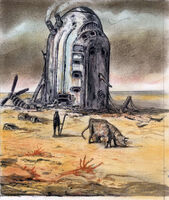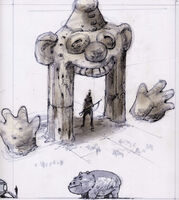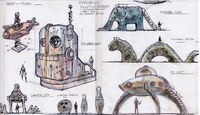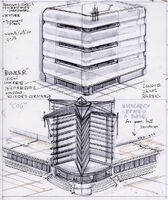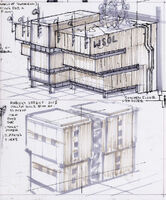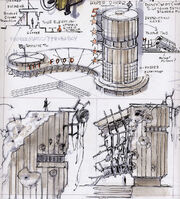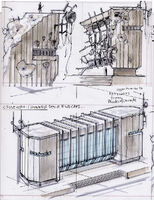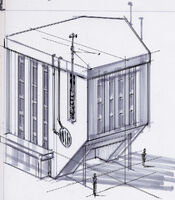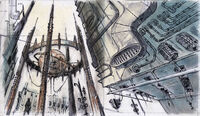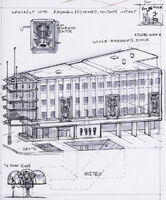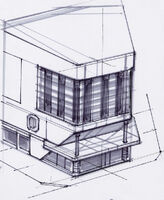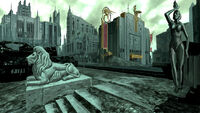| 關於map of the Capital Wasteland,參見Fallout 3 map。 |
首都廢土是華盛頓哥倫比亞特區的廢墟及其周邊地區的通用稱呼。西北方以Raven Rock為界,向東南方延伸至鉚釘城,波特馬克河大致將這片廢土劃分為兩塊。
在核大戰之前,這一區域是哥倫比亞邦聯的一部分,除哥倫比亞特區之外還包括如阿靈頓、安納戴爾、貝塞斯達、春之谷、傑曼敦和奧爾尼等主要城市。在2077年發生的事件中,華盛頓市遭到大量的核彈攻擊,白宮被徹底摧毀,城市變為廢墟,周邊地區遭到輻射污染。
在核彈襲擊中,一些導彈的目標定為附近的Fort Bannister。該要塞被直接擊中,而其周邊的地區也遭到徹底毀滅,直到2277年,廢都的西部邊緣仍然是了無生機的貧瘠荒漠,並且含有很高的輻射。
核災變使得貝塞斯達成為一個由匪徒佔據的廢墟,奧爾尼成為「舊奧爾尼」並且被死亡爪毀滅,安納戴爾成為了安戴爾,居住著一群食屍者。阿靈頓除了Mama Dolce's和國家公墓之外一無所有。春之谷被炸彈毀滅,成為了廢棄的城鎮。而傑曼敦現在是超級變種人的駐地。
許多前美利堅合眾國的歷史遺迹現已成為超級變種人聚集的廢墟,如國會大廈、科技博物館、美國歷史博物館、以及商業區等地。或者,像白宮那樣變成了一個充滿輻射的大坑。然而,在戰爭的灰燼之上也建起了新的城鎮,如兆噸鎮、鉚釘城、十便士大樓、地底城和小燈火鎮,除此之外還有些小的居民點,如戴夫共和國、綠洲、大鎮、斷橋鎮、Andale、the Temple of the Union、坎特伯雷居民區以及梁影鎮。
這片土地上影響力最大的勢力包括鋼鐵兄弟會東海岸分部,其基地設在由五角大樓廢墟的地上和地下部分組成的大本營;英克雷,隱蔽在Raven Rock的地下;從87號避難所出現的超級變種人;居住在失落天堂的奴隸販子;Fort Independence的兄弟會遺棄者;佔據著Fort Bannister廢墟的鷹爪公司傭兵;以及在整個區域中分布廣泛的匪徒,其中最大的一個匪徒營地是常青寨。
Environment[]
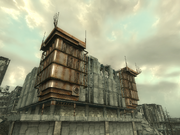
A building reinforced with armored screens to increase its survival chance against a nuclear attack. These corner-mounted installations would also serve as hardpoints for air defense, such as sirens, spotlights and similiar.[1]
The region known as the Capital Wasteland has been severely warped by the apocalypse. Although it was a lush temperate region before the war, the climate shift caused by the unprecedented scale of nuclear warfare unleashed on the world has led to desertification. Once made fertile by the Potomac, the Capital Wasteland turned increasingly desolate as the river dried up over the years. By 2277, the once-mighty river is little more than a swamp, with wastelanders able to cross it with dry feet in most places above roughly the neighborhood of Foggy Bottom. The drying up of the watershed has impacted the ecosystem and agricultural prospects in the region, with most plants unable to thrive in these conditions and the population of animals falling down accordingly.[2]
The situation changes in the more urbanized areas of the region. Washington, D.C. weathered the nuclear storm but sustained severe wounds in the process. Much of the downtown area of the city has been reduced to rubble, its buildings but shells containing hundreds of tons of rubble. Certain neighborhoods evaded complete destruction and remain in better shape, although that's not saying much. Curiously, the automated infrastructure has survived intact, with automated power stations continuing to provide power, allowing capable survivalists to benefit from the technology of the ancients.[3]
The adjoining territories of the pre-War states of Maryland and Virginia are home not only to derelict villages and townships, but also remnants of the pre-War grandeur of the United States: the grand Fort Bannister and the mysterious Fort Constantine, the crumbling Wheaton armory and National Guard depot, and what remains of its industry; the Corvega factory and the Nuka-Cola plant, as well as the extensive pre-War power line and monorail networks of Virginia and Maryland are but a few examples.
Flora[]
Compared to the rest of the United States mainland, the Capital Wasteland appears to suffer from severe contamination. Even two centuries after the war, the remaining radiation continues to interfere with agriculture, with all but the hardiest mutated plants able to take root in the contaminated soil.[4] Most cities cannot support regular agriculture and trade for the necessary food. A fine example is Megaton, which has its own water treatment plant, but lacks agriculture and buys its food from traders.[5]
Fauna[]
Much of the wildlife inhabiting what is now called the Capital Wasteland died out. While the ecosystem has been severely damaged, some species survived and adapted to the changing circumstances. For instance the mirelurks are pre-War crab and turtle species that inhabited the Potomac, which has adapted to survive in the radioactive waters of the semi-dried upriver.[6][7] Yao guai are also fierce, mutated bears indigenous to the region, whose natural lethality and resilience were only enhanced by radiation-induced mutations. radscorpions are also a common sight, evolved in much the same way as their cousins in the west. Their smaller insectoid siblings, bloatflies, have also increased in size, though are relatively harmless – and a good source of protein for hunters.[8]
The relatively stable, even natural ecosystem that emerged in the Capital Wasteland is disturbed by a unique type of wildlife, endemic to the border areas of Virginia: Vault 87 super mutants. These giant, yellow-green beasts have a rudimentary level of intelligence and are capable of constructing simple structures and clothing, as well as operating tools of varying complexity. A fixture of the Wasteland since 2078, they became a permanent nuisance, dragging away people to be turned into super mutants, but never achieving major success due to their brain damage and lack of organization. Unlike other animals, super mutants are seen largely as pests and culled appropriately when practical.[9]
Economy[]
In general, the economy of the Capital Wasteland for much of its existence was predominantly focused on subsistence and scavenging. The depopulation through nuclear fire has ensured that vast amounts of wealth remain untapped within the ruins, for those brave enough to enter them and scavenge. As mentioned above, slavery was a particularly lucrative business, though with a limited clientele, though certain locales, such as The Pitt and Paradise Falls have a high demand for slaves.[10] Hunters could also expect to make a good living in the wasteland, as the changed ecosystem still produced prey that can make for a fine source of meat – even if that prey moved on two legs.[11] The only settlement with a major agricultural output was Rivet City, the primary supplier of edible, non-irradiated food in the Capital Wasteland, trading foodstuffs grown in its hydroponic bays for essential raw materials with other communities.[12]
Despite the harsh realities of the wasteland, a caravan route was set up by Canterbury Commons' "Uncle" Ernest Roe, providing one of the few reliable links between existing settlements. It was maintained by four merchants with modest protection and provided much needed economic exchange between the isolated settlements in the wasteland.[13] Another trade route led as far as Point Lookout, operated by Tobar, who exchanged punga fruit and other goods produced in the region for salvage and other necessities produced by the Capital Wasteland.[14]
Two weeks after the Battle of Project Purity, water merchant caravans could be found, transporting Aqua Pura to denizens all across the wastes, though some took advantage of the opportunity by selecting certain clientele and selling them snake oil.
By 2287, with the activation of Project Purity and the Brotherhood's rapid recovery, the situation stabilized greatly. The Capital Wasteland became a major exporter of water and salvaged technology, enabled by the Brotherhood's firepower and Vertibirds.[15]
Politics[]
2277[]
Compared to the developed lands of the West Coast, the Capital Wasteland lived up to its name after two centuries. The individual settlements were few and far in between, with the heavy presence of wild animals and especially human raiders, as well as the absence of viable farmland or stable sources of water heavily inhibiting the ability to recover. The largest settlement and de facto hegemon of the Wasteland was Rivet City, the primary supplier of edible, non-irradiated food in the Capital Wasteland, trading it for essential raw materials with other communities.[12] Its scientific prowess was thanks to its aggressive reclamation efforts: anything useful was snatched up and brought to the City.[16] However, it refrained from recruiting scientists from outside settlements, such as the Underworld or Tenpenny Tower, as the vote proposing such an initiative failed in the council.[17] The city also had the fourth most powerful military force in the wastelands, right after the Enclave, Lyons' Brotherhood of Steel, and Talon Company. Although named as a simple security force, combat training was provided by wasteland veterans (Lana Danvers and Harkness) and each trooper was equipped with military-grade Army combat armor and automatic weapons.[12]
The Enclave was briefly the single most powerful faction in the wasteland, boasting a coordinated, regimented army backed up by Raven Rock's industrial capacity, a fleet of Vertibirds, robots, and political leadership of John Henry Eden. However, internal disagreements coupled with a series of tactical and strategic blunders brought an end to its aggressive campaign of expansion into the Capital Wasteland. The Enclave was reduced to disorganized remnants after their defeat during Purifier Conflict, following the loss of all their major command centers, weapons stockpiles, and the bulk of their manpower.[18]
Lyons' Brotherhood of Steel entered the year as a diminished, weakened force, suffering from a shortage of qualified combat personnel and severely depleted stocks of weapons and equipment, a direct result of twenty years of attrition warfare against the super mutants. Though once it reached far up the Potomac and its patrols protected settlements like Megaton, the Brotherhood's presence was eventually limited to the Citadel and only a handful of reinforced outposts scattered across the District of Columbia metropolitan area.[19][20][21][22][23] The legacy of the war with the mutants was amplified by the Schism and the formation of the Brotherhood Outcasts in 2276. A year after the split, the Outcasts expanded into the wasteland with regular patrols scouring the wasteland for technology and began to excavate several locations, including the Virtual Strategic Simulations facility, in order to complete their original mission objectives. Ultimately, they planned to regroup with loyalist chapters in the West, though that plan was put off due to the need to protect Fort Independence and their considerable stockpile of powerful technology.[24] However, the defeat of the Enclave brought a much-needed injection of ordnance and technology, allowing Lyons' chapter to make a dramatic return within the next decade.[18]
Beyond the three organizations, the largest active group was the Talon Company. Rumors circulated that an unknown client has hired it to instigate a campaign of terror, preventing any meaningful recovery from taking place.[25] Slavers of Paradise Falls, a major supplier of slaves to The Pitt and clients throughout the Capital Wastes, were disinterested in power plays and focused on enslaving the weak for the benefit of the strong – and their own coffers.[10]
There were plenty of other, smaller settlements in the Capital Wasteland of 2277, existing outside the rudimentary power structures. The most unique of these was the Underworld, a haven for ghouls set up in the Museum of History. As it lies in the center of an active war zone, it was fortified to defend against all but the most persistent of attackers.[26]
2287[]
Following the disastrous conflict with the Enclave, the Brotherhood enjoyed a stable, but hardly unrivaled position. Suffering from severely depleted stockpiles and shortage of manpower at the beginning of the conflict, casualties taken during the fight with the Enclave and the loss of their most important military asset, Liberty Prime, made the future uncertain. Occupied by its research into the Enclave technology and the amount of gear and weapons it recovered, the Brotherhood slowly regained strength as it slowly chipped away at the years-long process.[27][28] One of the greatest achievements of the Brotherhood of this time was starting the construction of the Prydwen, an armored airship greatly increasing the Brotherhood's ability to project power.[29]
The biggest setback suffered by the chapter was the death of Elder Owyn Lyons circa 2278 and the loss of his successor, Elder Sarah Lyons, later that same year. With the seat of power emptied, the remaining Brotherhood members elected multiple ineffectual leaders, while the adolescent Squire Arthur Maxson matured into a capable warrior and tactician, eventually securing a victory over Shephard, the new warboss of the Capital Wasteland super mutants, in 2282. This feat earned him a provisional leadership position. In fact, this position was bestowed by West Coast Elders, who revealed that they still monitored their errant brethren. Maxson's position solidified in 2283, when he negotiated a treaty with the Brotherhood Outcasts, bringing them back into the fold and reforming the entire organization, merging Lyons' Doctrine with salvageable elements of traditional doctrines. Lyons' Brotherhood became a distant memory as Maxson took the united Brotherhood forces into a new direction. While some members found this distasteful and deserted,[30] many more remained, proud to serve a refocused Brotherhood.[31]
As a result, the Brotherhood became the single most powerful organization in the Capital Wasteland, exercising firm control over the region out of the imposing Citadel[32] and Adams AFB.[33][34] Under its control, the wasteland is a stable place, exporting goods and giving wastelanders a chance at a life beyond mere subsistence.[15]
出場[]
廢都只在輻射3中出現。It is also mentioned frequently in Fallout 4 and Fallout 76 and its update Wastelanders.
Gallery[]
References[]
- ↑ Pentagon concept art:
"Armor clad corners in case of attack
-Used as sign marquee
-Bottom half civic hardware (traffic lights, street lights, etc.)
-Top used for communication, surveillance, air raid sirens/spotlights.
-Used especially to protect historic monuments..." - ↑ The environment of the Capital Wasteland as portrayed in Fallout 3.
- ↑ 引用错误:无效
<ref>标签;未给name属性为Power source的引用提供文字 - ↑ The Lone Wanderer: "Okay, I'll get irradiated. Just be ready to fix me up when I get back."
Moira Brown: "Oh, you're a peach! Or, at least, some sort of hardy fruit that grows in the savagely irradiated mockery of agriculture we have nowadays. Now, 200 rads should be enough for basic sickness, but if you can get 600 or more rads, my tests will be even more accurate. Just make sure you can get back here, and I'll see to it that you're well taken care of!"
(MoiraBrown.txt) - ↑ The Lone Wanderer: "I encountered some Raiders, but they were easily outsmarted."
Moira Brown: "Guess I wasn't the first to think of checking out a food store for storing food. Huh? Well, keep what you got. Just traded for a big food shipment, myself. Here, take a bit, my treat - the taste kind of grates after a while."
(MoiraBrown.txt) - ↑ The Lone Wanderer: "They're pretty much crab-based humanoids."
Moira Brown: "Hrm. That's not a lot more than I knew already. But it's interesting that they're adapted for the radioactive water. I wish we could have gotten more information, but this'll have to do for the book. Here's your pay. Maybe they'll help you be sneakier next time."
(MoiraBrown.txt) - ↑ The Lone Wanderer: "They descended from local crabs. I'd call them "Scylla Serrata Horrendus.""
Moira Brown: "That's very scientific of you! Personally, I wasn't sure if they were crabs or if they came from some sort of brine shrimp, perhaps. Some of these observations about their armor and camouflage gave me an idea for reinforced, neutral-colored headgear. Here, consider it thanks for not interfering with them. Oh, speaking of which, take these. So you can continue to avoid them in the future."
(MoiraBrown.txt) - ↑ Individual animal appearances.
- ↑ Fallout 3 Official Game Guide Game of the Year Edition p.42: "Super Mutants"
"The Super Mutants that infest the urban ruin of Washington D.C. originated in Vault 87. Those unlucky enough to have reserved space in Vault 87 soon found themselves forcefully taken to a secure part of the vault, where they were locked in airtight chambers and exposed to a concentrated form of the F.E.V. The Overseer and his security force had no real idea what to expect; they were simply following the "plan." When the exposed vault dwellers started transforming into Super Mutants, nearly the entire vault population had been exposed. Those who hadn't yet metamorphosed knew what was coming, and, well...it didn't end well for humanity.
The dwellers of Vault 87 were turned into Super Mutants in 2078, and have been a presence in the Capital Wasteland ever since. Most of those original Super Mutants have long since been killed. But whether it's because of the nature of the F.E.V. they were exposed to, or a simple underlying human instinct, the Super Mutants of the Capital Wasteland are obsessed with the preservation of their own species. Super Mutants are asexual and incapable of procreation, so their only way of reproducing is to kidnap other humans, drag them back to the Vault 87 chambers, and infect them with F.E.V. And so they have done, for nearly 200 years.
Super Mutant society is loosely hierarchical, with the weaker (most recently transformed) Super Mutants generally giving way to the stronger. The Super Mutant hierarchy, as defined by the Capital Wasteland contingent of the Brotherhood of Steel, is as follows: Grunt, Brute, Master, and Behemoth. Generally speaking, the Super Mutants of the Capital Wasteland get bigger, stronger, and dumber as they age. The Behemoths are so strong and savage that they’re the only thing feared by the other Super Mutants."
(Fallout 3 Official Game Guide faction profiles) - ↑ 10.0 10.1 Fallout 3 Official Game Guide Game of the Year Edition p.42-43: "Slavers
The Slavers of the Capital Wasteland are headquartered at the compound of Paradise Falls and led by the charismatic and ruthless Eulogy Jones. Slavery has nothing to do with race, and everything to do with the subjugation of the weak for profit. The Slavers have a pretty limited clientele, and sell mostly to their return customers, the Raiders. Other customers are residents of the Wasteland, including Alistair Tenpenny, creator of Tenpenny Tower."
(Fallout 3 Official Game Guide faction profiles) - ↑ The various Fallout 3 hunter random encounters.
- ↑ 12.0 12.1 12.2 Rivet City terminal entries; Bannon's Terminal, Council Meeting Minutes
Rivet City terminal entries; Doctor Li's Terminal, Council Meeting Minutes - ↑ Merchant Empire quest.
- ↑ Tobar
- ↑ 15.0 15.1 引用错误:无效
<ref>标签;未给name属性为:2的引用提供文字 - ↑ The Lone Wanderer: "You know who might have a Lipoplasticator or Micro Dermal Graftilizer?"
Church: "Probably down at Rivet City. Anything that has any use out here, they snatch up for themselves. That damn Pinkerton don't share nothin'."
(DocChurch.txt) - ↑ 引用错误:无效
<ref>标签;未给name属性为RCC1的引用提供文字 - ↑ 18.0 18.1 See Purifier Conflict, Enclave for sources.
- ↑ The Lone Wanderer: "Anything you can tell me about the Super Mutants?"
Owyn Lyons: "Would you believe... "no"? It's pathetic, really, considering we've been fighting those abominations for nearly twenty years. In all that time, all we've managed to do is contain the threat. Hold them back, so they don't overrun every blasted settlement out here. But we don't really "know" anything. Where they're from, why they've infested the D.C. ruins. And now here we are, holed up in our Citadel. Low on resources, low on troops. It's enough to make an old man so very... tired."
(Owyn Lyons' dialogue) - ↑ The Lone Wanderer: "Those sound like pretty good changes to me."
Reginald Rothchild: "You're an outsider. I don't expect you to understand. We live and die by our dedication to the Brotherhood. To go against orders... It's not something that's done. I appreciate that Lyons believes he is doing what is right, but he should never have disobeyed orders. And now look where it's gotten us. Forces dwindled, Super Mutants on one side, Enclave on the other. We can barely take care of ourselves."
(Reginald Rothchild's dialogue) - ↑ The Lone Wanderer: "What does the Brotherhood believe?"
Elizabeth Jameson: "We believe in technology, in the triumph of the creations of the ancients over the horrors and evils of the Wasteland. We believe in trust. Trust in technology. Trust in our fellow Brothers. Trust in our Elders. Ah, and we believe in victory. Our forces have dwindled, but still we fight on. Super Mutant, Enclave, it matters not. Surrender is not an option."
(Elizabeth Jameson's dialogue) - ↑ The Lone Wanderer: "You must see a lot of things. What's been going on?"
Artemis: "What's been going on? Well, let's see. For years, we've been draining our resources defending the ungrateful residents of this no man's land. Most of my best friends have either been ripped apart by Super Mutants or left to join the Outcasts. And now an enemy we faced more than thirty years ago has resurfaced, and their tech is still better than ours. What's been going on with you?"
(Artemis' dialogue) - ↑ Elder Owyn Lyons -- Personal Log 2: "Here I sit, in the safety of the Citadel, while the people of the Wasteland thirst, and suffer, and die. Here I sit, a failed, feeble old man. What have I really accomplished? How many have I truly helped? The Super Mutants still roam rampant. The people still die of thirst and radiation. The Western Elders cease to acknowledge my existence. Some of my own people have even gone Outcast. And now... the Enclave. Technologically superior. Infinitely resourceful. The time has come to pass the mantle to more able hands. But is she ready?"
- ↑ The Lone Wanderer: "Tell me about the Outcasts."
Anne Marie Morgan: "We collect technology, and most people want what we've collected. Right now, we're pretty much stuck defending this Fort, but that won't be forever. Once we regroup, we'll continue our work and keep moving back west."
(DefenderMorgan.txt) - ↑ Fallout 3 Official Game Guide Game of the Year Edition p.41: "Talon Company Mercenaries
The Talon Company is the largest of the mercenary groups in the Wasteland. They can be found almost anywhere. They put cash and loot ahead of almost anything, and will attack most groups on sight in the hopes of taking their stuff. Currently an unknown benefactor has hired the Talon Company to hunt down do-gooders. The reasons for this are unknown, but the effect is to keep the Wasteland a lawless place where the guys with the biggest guns make the rules. The Talon Company frequently has the biggest guns."
(Fallout 3 Official Game Guide faction profiles) - ↑ Fallout 3 Official Game Guide Game of the Year Edition p.43: "Underworld Ghouls (Non Feral)
The Underworld Ghouls are a group of refugees who have taken up residence in the remains in the Museum of American History. They mostly keep to themselves, doing their best not to draw attention from the outside world and its prejudices. They are known to welcome visitors, so long as those visitors behave themselves. But even as they welcome newcomers, the Ghouls of Underworld are cautious and wary of strangers. Each was subject to abuses by humans in the past, and as a result, their trust is easily revoked."
(Fallout 3 Official Game Guide faction profiles) - ↑ The Lone Wanderer: "So, what happens to the Brotherhood now?"
Reginald Rothchild: "I've been amazingly busy ever since we began clashing with the Enclave. All their technology is amazing. It's going to take me years to sift through the wreckage of their mobile platform alone. I suppose we have you to thank for that."
(Reginald Rothchild's dialogue) - ↑ The Lone Wanderer: "So, what happens to the Brotherhood now?"
Vallincourt: "Now? Now the real work begins. I've got just piles and piles of Enclave technology to take apart and put back together. Who do you think got our captured Vertibird flying? Now let me get back to work before Rothchild assigns me trash detail."
(DLC03ScribeVallincourt.txt) - ↑ See the The Prydwen article for details.
- ↑ The Sole Survivor: "What's your story?"
The Scribe: "I was once a Scribe in the Brotherhood of Steel. Back when that was something to be proud of. Back when we used our knowledge to help people, rather than simply hoarding it for our own power. When Squire Maxson took over... well, I didn't like the changes he made to the Brotherhood. Some said it was a return to our ancient traditions. Maybe so. But things are not necessarily better simply because they are ancient. So, I left. Since then, I've been walking up and down in the world... until I found myself here."
((The Scribe's dialogue) - ↑ Brotherhood soldier: "I'm proud to be serving under Elder Maxson. I had enough of Lyons and his foolish ways."
- ↑ The Sole Survivor: "Why establish an outpost at the police station?"
Danse: "Given the nature of the facility, we felt it would be tactically advantageous to search it for weapons and ammunition. The radio tower on the roof was an unexpected boon, but it obviously has its shortcomings that need to be rectified. It might not be as imposing as the Citadel back in the Capital Wasteland, but it suits our purposes. That's all I'm willing to divulge at this point. Are you ready to proceed with the mission?"
(Danse's dialogue) - ↑ The Sole Survivor: "Where was the Prydwen constructed?"
Kells: "She was constructed at Adam's Air Force Base just outside of Washington D.C. There was a vast amount of scrap metal and salvageable components there after we defeated the Enclave. We spent the first two years alone gathering the parts. The rest was spent assembling. It was worth the effort. With the Prydwen in our arsenal, we can mobilize our entire division... sending her anywhere that Elder Maxson wishes her to go. Her presence in the Commonwealth ensures that our mission to defeat the Institute will end in victory."
(Kells' dialogue) - ↑ The Sole Survivor: "You sure Ingram knows what she's doing?"
Arthur Maxson: "Proctor Ingram's managed to keep a 40,000 ton airship aloft for the past five years. I'd say that earns her the benefit of the doubt."
(Arthur Maxson's dialogue (Fallout 4))
| |||||||||||||||||||||||||||||||||||||||||||||||||||||||||||||||||||||||||||||||||||||||||||||||||||||||||||||||||||||||||||||||||||||||||||||||||||||||||||||||||||||||||||||||||||||||||||||||||||||||||||||||||||||||||||||||||
